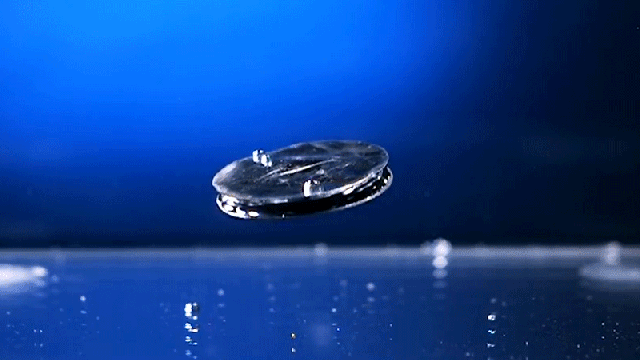Inspired by the way diving bell spiders and fire ants use their water-repelling legs and bodies to trap air in order to float on water, researchers from the University of Rochester have found a way to make solid metal structures float on water, potentially paving the way for unsinkable boats or smartphones that won’t immediately sink when accidentally dropped in a toilet.
[referenced url=” thumb=” title=” excerpt=”]
Unlike spiders and fire ants, air doesn’t naturally stick to metallic surfaces. In order to raise sunken vessels, rescue crews will often rely on giant rubber balloons pumped full of air and attached to a damaged metal structure to make it buoyant again. The University of Rochester researchers realised they could use both approaches to create a metal structure with new properties that made it naturally trap air inside it, which would, in turn, ensure it was all but impossible to sink.
The first step was to treat a metal using a laser etching technique that made it superhydrophobic—or extremely water repellant. The technique they developed initially took about an hour to etch a square piece of metal that was just an inch long on each side, but the process was sped up dramatically after switching to more powerful lasers. And while the researchers opted for aluminium for their experiments, they believe the superhydrophobic etching treatment could not only be applied to any type of metal but other materials as well.
With the etching complete, the next step was to make a metal sandwich using two parallel aluminium plates sitting very close to each other, but not touching, and with their superhydrophobic surfaces both facing inward. The deliberate gap between the two plates traps air and holds onto it even while the entire metal structure is submerged, creating sufficient buoyancy to keep the metal sandwich afloat.
Through experimentation, the researchers were able to determine the ideal gap between the metal plates to create a waterproof compartment that holds on to enough air to counteract the weight of the entire structure. Even more remarkable is that the trapped air remains trapped almost indefinitely, which the researchers discovered after deliberately submerging one of their aluminium water-repelling sandwiches underwater for two whole months after which it immediately floated back to the surface once released.
Even when the metal sandwich was punctured full of holes, it still remained buoyant enough to float, which has made the researchers confident that their discovery could be used to design and build boats that could remain afloat even when damaged. The approach could even be used to make other vehicles or structures buoyant for safety or security reasons, such as aircraft crisscrossing the oceans where there’s a risk of having to make emergency landings in water if there’s ever a problem.
